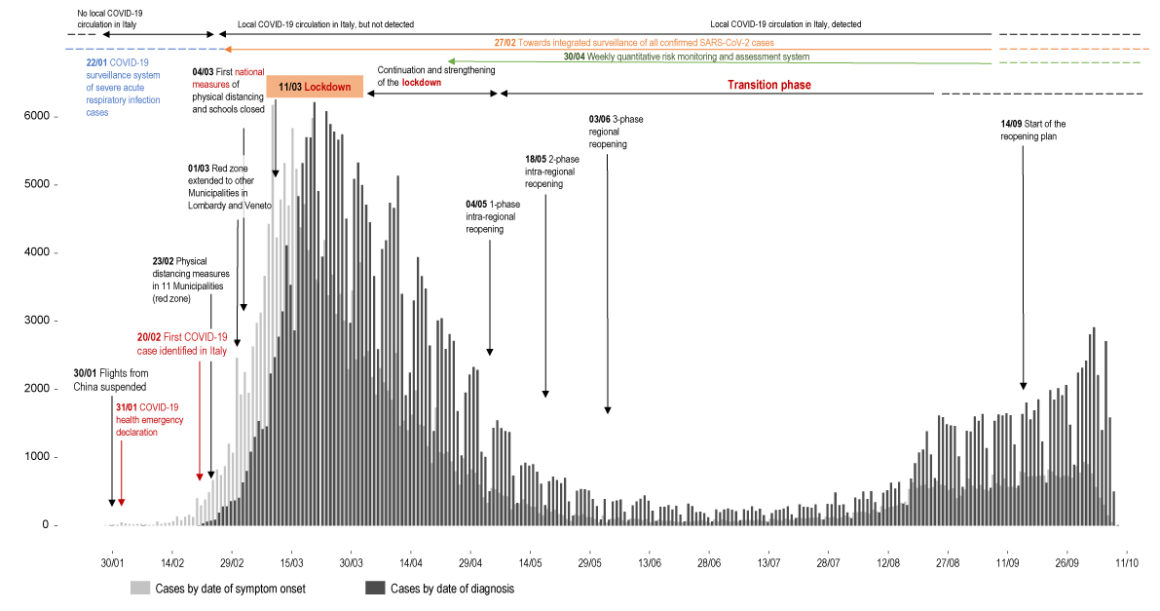Two years have already passed since the pandemic began. During this time we have learned how to handle the emergency, starting precisely from the data.
The Italian health system meets COVID-19
Since the first days of the pandemic, a crisis unit has been activated. In Italy, Law 833/1978 establishes the framework for the national health system, based on the fundamental rights of the individual and the interests of the community. This service is structured by a central government that guarantees the essential levels of care, and by 20 regions able to offer services to the public.
Due to the spread of COVID-19 and the resulting constantly changing situation, stringent containment measures have been adopted. The main objective of these interventions was to prevent and mitigate the associated risks.
The first cases and the government’s response
In response to the pandemic, the government intervened in two directions.
The first was the “Disaster Mitigation Stage“, which aimed to minimize damage and save lives by establishing risks and vulnerabilities. Initial measures consisted of reducing the risk of transmission, through scanners and health checks, and in consideration of ships and planes that entered the country. The Scientific Committee on February 12, 2020, produced a report, in which possible scenarios for the spread of the coronavirus were analysed.
The second step was the “Disaster Response Stage“, whose objective was to save lives and meet a series of emergency needs. The ISS document, which assessed the risk and vulnerability relating to these epidemics, outlined that response depended on the current and future territorial-level preparedness capacity.
When the first case came up, it was too late to contain the coronavirus in Italy. The first cases discovered were detected on 21 February 2020 in the North. In just a few weeks, 3916 cases were reported from the first confirmed, and on 11 March the WHO declared the pandemic. In those days the total number of cases was 12462 and deaths were 827.
After the first measures, 11 Municipalities of Lombardy and 1 in Veneto went into the first lockdown on 23 February. From this moment, different protection zones and a series of Decree Laws took place. On March 9, a decree established a single red zone applied to the entire country. Two days later, all non-essential businesses were closed and remote business activity was encouraged. The movement of people was restricted and the word “lockdown” definitely entered our everyday life.
Overview of monitoring
Data is instrumental in managing the pandemic. Through the use of indicators, it is possible to predict probability, resilience, and impact. Depending on the criticality found by analysis, the level of risk belonging to a region is consequently decided. In Italy, the public health system is regionalized. This means that all data arriving from the territory and from the hospitals are collected by the ASLs, which then, in turn, present it to the Region or the Autonomous Province. Thereafter, the Regions or the Autonomous Provinces send the surveillance data to the ISS, and they return the information. This sort of continuous contradiction guarantees the quality and correctness of the information provided.
Since the beginning of the emergency, the publication of the aggregated data provided by the Ministry of Health and the Civil Protection has been presented on a daily basis.
This made it possible to monitor the progress of the COVID-19 outbreak and accordingly flatten the curve of the epidemic, as shown in the following graph over a given period:

Example of management of the pandemic in Italy, epidemic curve, from 30 January to 6 October 2020. Original source: COVID-19 integrated surveillance
To evaluate the effectiveness of the implemented measures, the national transmission index (Rt) is used. It is calculated on a statistical basis from a daily case incidence curve and indicates the potential transmissibility of infectious disease. So it is useful for predicting hypothetical scenarios of transmission of the SARS-CoV-2 virus. Another important indicator considered is the occupancy rate for COVID-19. It takes into account the risk scenario, which ranges from 1 to 4. In this way, the best course of action can be determined.
Information flow
Data is continuously monitored to avoid errors such as duplicates and incorrectly entered information. Regions and Autonomous Provinces check the previous week’s data on Mondays and Tuesdays, which are then structured every Wednesday for risk analysis. On Wednesday evening, the preliminary data analysis is sent to each Region and Autonomous Province, in particular the indicators used by ISS for risk assessment. On Thursdays, the ISS receives any corrections, and in the evening the final report is generated and presented on Friday morning to the technical-scientific committee or to the responsible bodies. It is also forwarded for publication on the websites of the Ministry of Health and the ISS.
In the following video, it is explained how the flow takes place, its characteristics and uses, the decision-making process.
Interviewees


Senior Researcher in the Department of Infectious Diseases at ISS, Flavia Riccardo.
ph Mary Fagioli
Senior Executive at Lazio Regional Health Service, Sara Farchi.
ph Mary Fagioli
Understanding data and the LAB24 case
All the data aggregated are available on GitHub. These are Open Data and the author is the extraordinary Commissioner for the Covid-19 emergency – Presidency of the Council of Ministers, copyright 2021.
They can be extrapolated and structured for many uses. The LAB24 data journalism project is an example. It aims to tell stories, inquiries, and insights in real-time, through the use of data, videos, and interactive representations. It was born a couple of years ago from the aspiration to produce more visual journalism and use all that data became central to any journalistic analysis, according to Data Analyst Alberto Guidi. One of their stories is focused on the Coronavirus in Italy.
In the beginning, the team encountered some difficulties in processing the piece, especially as regards the data formats offered, such as .pdf. Pulling data out of this human-readable format can be a difficult task. Furthermore, the initial vaccination data were organized in macro-categories which, however, did not consider some important features, such as the reference population. Nowadays, the data provided are more detailed, and present first, second, and third doses, age, categories belonging to the police, school staff, reinfections, and people who have taken single doses. Some significant evidence is still missing, in terms of effective access to intensive care, according to Alberto Guidi. When only the total is provided, it is not clear whether deaths or healing are linked to that. Having more specific details on this might be helpful. As well as having a more precise idea of the effects of the vaccine.
Open Culture
The progressive use of open sources results in a consequent culture of transparency. Public data according to the Digital Administration Code, Legislative Decree no. 82/2005, must be accessible without restrictions for public and private subjects. Furthermore, the open format must meet the requirements of availability in disaggregated format, of accessibility, and therefore suitable for automatic use by computer programs, including the related free-of-charge metadata.
Open Data is a subset of Big Data but with different purposes. While the latter can be treated without consent to discover behaviors and attitudes of citizens in the public sphere, the former has a more ethical purpose and can improve participation in public affairs. An Open Data structure relies on constant reporting from users to improve the database. On GitHub, for example, there are volunteer groups and curious and interested people who contribute to making some more in-depth analysis of the open-source data available.
Quality data drives better decisions
The pandemic has highlighted how important the management of health systems can be, both in terms of efficiency and decisions. To increase knowledge about vaccines and treatments, contain the virus, measure the social and occupational impact, and establish the effectiveness of a government response, the scientific, political, economic, and social communities need information.
In healthcare, all data can be obtained and generated following a data-driven perspective to capitalize and manage the departments. According to the DIKW model, at the base of this pyramid, there is precisely the data, which can be demographic, patient, laboratory, and so on. The data, if correctly interpreted, cleaned, and processed, become resourceful. After giving context to the data is developed a framework, which represents potential solutions to problems and decisions to be implemented. Lastly, there is optimization for efficiency. It can be a strategic thinking model in which the communities understand not only what happens but above all why. From this perspective, hospitals and the healthcare system can benefit from more informed decisions and strategic growth.









